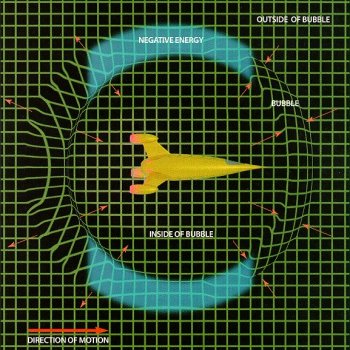warp drive

Warp drive is the principal means of interstellar propulsion in the Star Trek universe. According to the scriptwriters, it enables faster-than-light travel and uses matter-antimatter reactions inside a "warp core" (see antimatter propulsion).
Warp drive works by distorting the fabric of spacetime – contracting spacetime in front of the vessel and expanding it behind. The starship itself rests in a "warp bubble" between the two spacetime distortions. This warped spacetime, together with the region between it, accelerates at "warp speed" and the vessel then surfs the wave in spacetime thus created. Travel at velocities exceeding that of light is possible, without breaking the rules of special relativity because the starship is, strictly speaking, stationary (relative to the space of its warp bubble) while spacetime itself is moving. Since the starship isn't actually accelerating, it experiences no time dilation, allowing the passage of time inside the vessel to be the same as that outside it.
One way of making warp drive a reality might be the Alcubierre warp drive, proposed by the Mexican physicist Miguel Alcubierre in 1994. This would use a large flat ring of exotic matter around the spacecraft to warp spacetime in front and behind the vessel enabling speeds of up to 10 times the speed of light. Although the theory seems fine, the Alcubierre drive demands a vast amount of mass-energy to make it work – roughly the amount of mass-energy in the whole of the planet. Fortunately, it seems there may be a way around this horrendous technical problem. According to Harold White at NASA's Johnson Space Center (JSC), changing the shape of the encircling ring to a rounded torus, or doughnut, drastically reduces the amount of mass-energy needed by the drive, to about that contained in a small car. Speaking at the 100 Year Starship Symposium, in September 2012, White described how he and his colleagues have already started small-scale laboratory experiments to test the validity of their idea using a laser interferometer at JSC.


